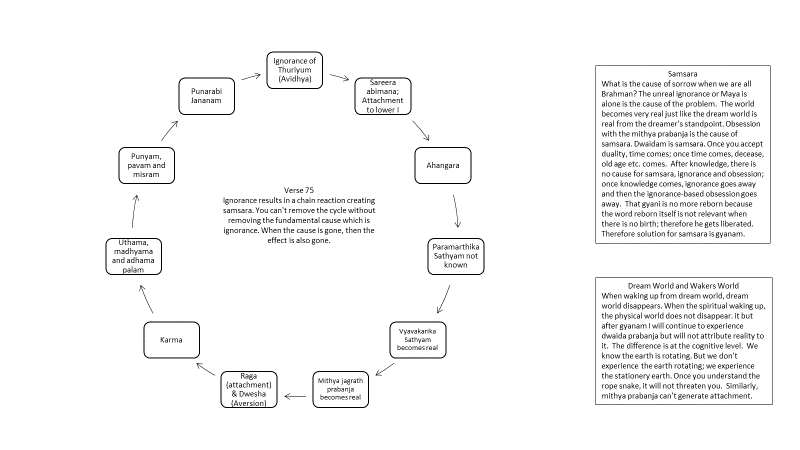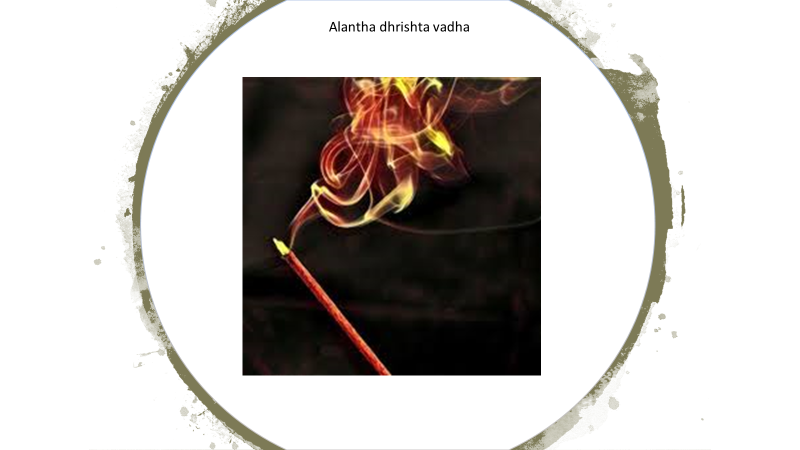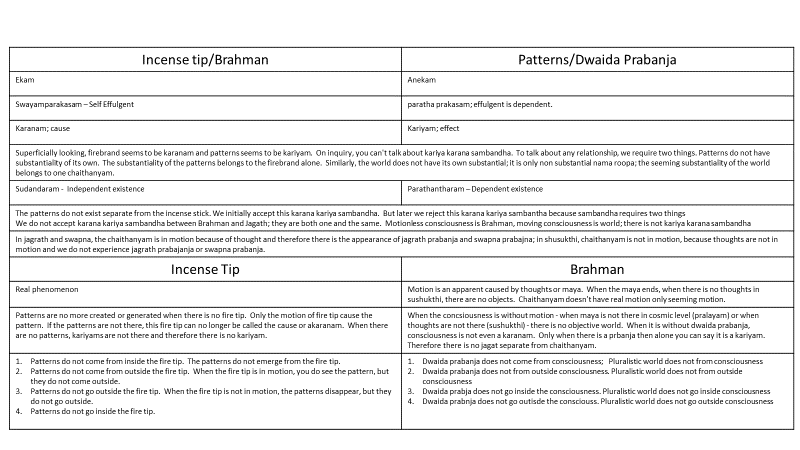Mandukya Upanishad, Class 73
Class
73

Gowdapadha is talking about the
problem and remedy for samsara. When I happened to be ever free Brahman,
why is it I am caught up in the cycle of samsara? In 75th verse, Gowdapadha says the cause is
ignorance which leads to chain reaction in the form of samsara. Ignorance
never comes, it is there from anadhi kala. The only saving grace is we
can put an end to ignorance; it is not ananda. Ignorance of thuriyum is
the cause for samsara. This ignorance by itself does not cause samsara;
but it leads to misconception of viswa, taijasa and pragya. Once I have
come down to viswa plane, the sthula prabanja becomes very real, just as the
dream objects looks real for a dreamer. Ahangara adhyasa or kama or
desire arises out of this ignorance. As viswa I am finite that sense
leads to my desire to complete myself with the things in front of me. Obsession
with the world which is really not there. Avidhya leads to ahangara;
ahangara leads to kama or desire; kama leads to karma; karma lead to uthama,
madhyama and adhama karma palam in the form of punyam, pavam and misaram.
This leads to punarabi jananam; you get ahangara etc. again in cycle. You
can’t remove the cycle without removing the fundamental cause which is
ignorance. First you remove avidhya, then ahangara goes away; I realize I
am viswa taijasa pragya vilakshanam. Then kama goes; and then not new
karma. When knowledge arises the gyani or jivatma never born again.
When the cause is gone, then the effect is also gone.
Verse 77
When the karmas are destroyed by
knowledge, then one gets moksha. This means moksha is a result obtained
in a particular time. Such a misconception can arise in a student’s mind;
we should never think moksha arrives or happen at a particular time. If
as a result of gyanam, samsara ends and moksha begins on a particular date,
then whatever has a beginning will also have an end. Therefore, we should
never conclude that moksha should begin at a time. Beginning of moksha is
a figurative expression for the removal of the notion that I am limited.
Moksha is my very real nature. Attainment of moksha is a figurative notion
for dropping the notion that I am bound. Moksha is not an event happening
at a particular time.
Moon falling into well and being
pulled out by mulla is compared to getting moksha.
Jivatma attains birth lessness,
seemingly come to jivatma. The jivatma free from all karma, which are
responsible for punar jenma. Uthama, madhyama and adhama karmas are the
cause for punar jenma. Really speaking, jivatma is free from all vikara.
That atma alone appears as a pluralistic world. That jivatma appears to
obtain moksha, but moksha was there all the time. It is a freedom
existing all the time. Dropping the notion that I am not free is
figuratively called moksha. It is not divisible into past, present or
future. It is uniform and ever available. It is an eternal factor
because the bondage we talk about is not a real bondage; it is mithya.
Any object is mithya because it
doesn’t have an independence existence of its own; every object needs a subject
to prove its existences. This samsara cycle is mithya and therefore we
don’t require a freedom; we only need waking up and realize there is no problem
requiring remedy. You don’t solve the problem; you dissolve the problem;
you understand there is no problem to solve. Mukthi is my swaroopam.
Verse 78
Viswa, taijasa alone kartha.
The more I assimilate the fact that I am akartha the more I will realize I am
free from karma. I don’t need to exhaust karma. I am free from
sanjitha, agami and prarabtha karma all the time. This is my real
nature. Sanjitha karma is mithya; agami karma is mithya; prababtha karma
is mitha; kartha himself is mithaya. Nidhithyasanam is not to obtain
moksha but realize moksha is my real nature. Until this becomes clear
sravanam, mananm and nidhidhtyasanam must continue. A seeker should know
that I am karma rehitha – free from karma. I am not only free from karma;
I won’t accumulate fresh karma (agami) either. I am not a kartha
therefore I can’t accumulate fresh karma. When you see this fact and
clearly understood, you will attain moksha. His struggles for moksha will
end. Moksha is freedom from grief and all selfish desire which are born
out of apoornatvam the notion that I am incomplete. There is not wants in
life. If there are any desires, they are desires to contribute to other’s
poornatvam; non-binding desires. Constant insecurity is the reason most
of human action. Everything is driven by the fundamental insecurity and
it gets more intense as we get older. As we grow old, our insecurity
increases.
the word budhwa used by Gowdapadha
. Puja bakthi etc are glorious but none of them will solve the problem of
samsara. They all will prepare the mind to come to sravana manana
nidhithyasanam. All have to come to vedanta sravana, manana
nidhidhtyasanam.
Verse 79
How the persistence of agyanam will
keep the bondage going, is not said blindly. Light alone destroy darkness
is not a phototropism but a fact. For removing darkness there is only one
way – light. Multi path theory is illogical. We accept many paths
for chitha sudhhi – purifying mind. As long as you are attached to the
mithya sareeram, the viswa will get strengthened. From the standpoint of
mithya viswam, jagrath prabanja will not be seen as mithya and it will be seen
as sathyam. Only from thuriya dhrishty jagarath prabana is mithya.
From the standpoint of one mithya another mithya appears sathyam. Viswa
can’t avoid raga dwesha and raga dwesha can’t avoid pravirthi and nivirthi
(going towards and going away).



